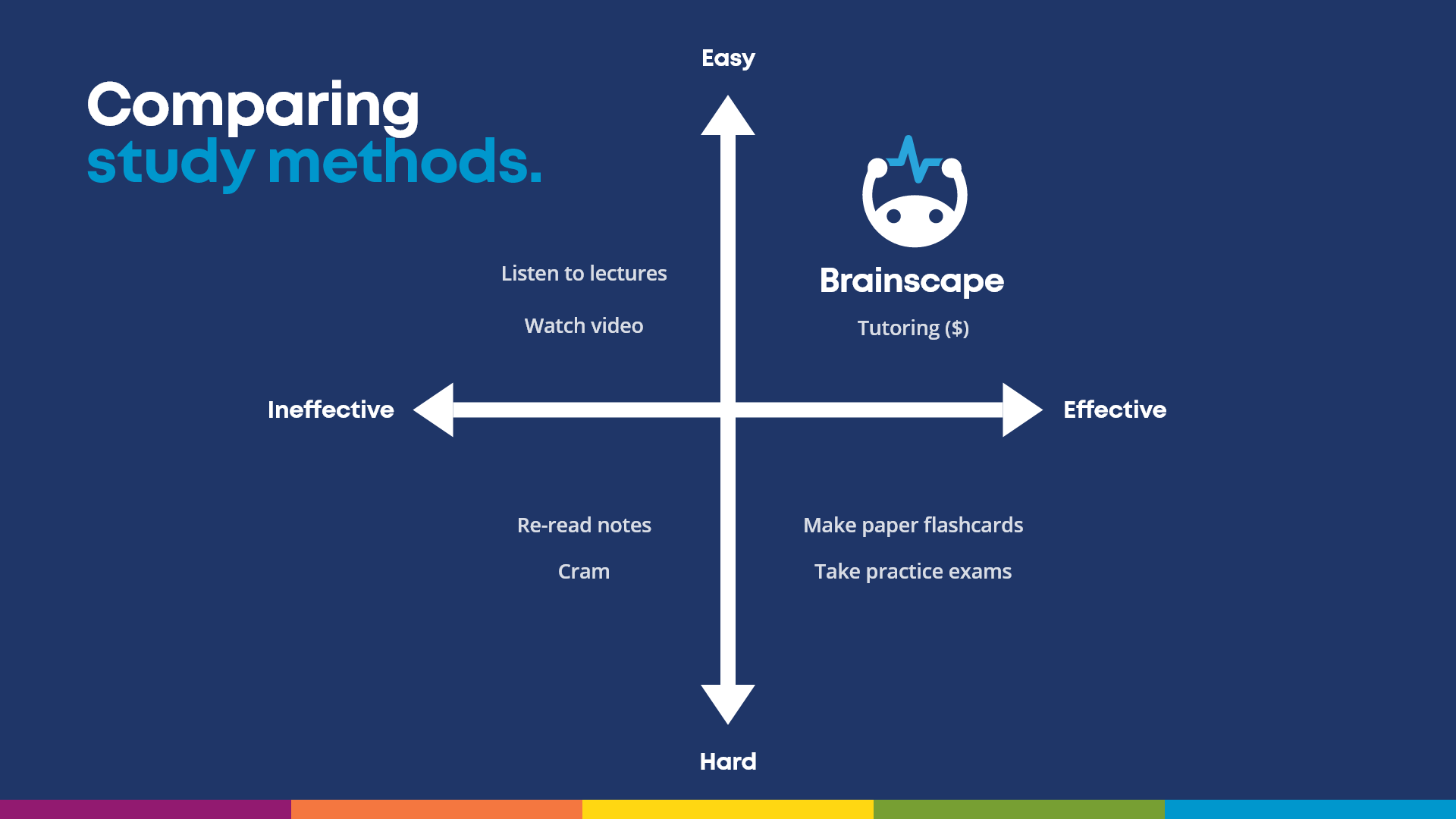I used to know this guy in college who got A's for everything bu hardly seemed to study at all. Annoying, right? While we were all sweating bullets with exam anxiety, cramming like crazy the day and night before finals, Haru was chilling, playing video games. He didn’t need to study, he said, because he'd "already done the work" ... during the semester.
We were all in awe of Haru, thinking he had a photographic memory or some other amazing cognitive talent that the genetic gods did not bestow onto the rest of us. It wasn't until later that we learned that Haru wasn’t the reincarnation of Albert Einstein, he just knew how to study effectively.
He had figured out the secret to passing exams with seemingly minimal effort; the Holy Grail of study techniques *insert angels singing here*.
It all comes down to this: you are cognitively wired in a certain way. Traditional approaches to studying don’t really take this into account when you attempt to learn new information. You just keep reading and cramming, hoping the necessary facts will stick around and show up when needed. But if this traditional approach really worked, a lot more students would perform a lot better at school, college, and life.
If, however, you work with your brain’s cognitive hardwiring, just like Haru—rather than struggling on in spite of it or even AGAINST IT—you can massively increase your knowledge retention, while decreasing the amount of time you need to spend studying.
Sounds like one of those too-good-to-be-true infomercials, doesn’t it? The ones with the smiling housewives that make motherhood look like a detergent-fueled dream devoid of backache, bacteria, and kid barf. It smells like banana bread and freshly-baked lies.
It’s not too good to be true, though. We at Brainscape know that there is a super simple study method that leverages decades of cognitive science research to help students onboard information more effectively so that they won’t forget it 24 hours after memorizing it. And we know this because our adaptive flashcard study platform is the product of this research.
So, if you want the time you put into your studying to yield much quicker, more permanent results, it’s time to do things a little differently. We’re going to show you right now in Brainscape’s ultimate guide to studying effectively with LESS net effort:
- Two approaches to studying
- Five principles of effective study rooted in science study
- Principle # 1: Learn how to read so that you learn what you read
- Principle # 2: Note-taking done properly
- Principle # 3: Consolidate notes soon after the lecture
- Principle # 4: Make study a daily practice
- Principle #5: Teach to learn
- Study effectively or cram? It's your choice
There are two approaches to studying

What kind of student are you?
Are you the kind who waits until an exam looms right over your head before you cancel everything on your calendar and cram like crazy? Do you spend your exam countdown in a sleepless, caffeine-fueled, and information-drenched stupor, emerging with just enough energy to somehow sit for (and scrape through) the exam?
This is the first approach to studying and it's cramming. Hey, if it makes you feel any better, you are one of the vast majority of humans on the planet who study this way. Yet, for an approach that is so widespread, cramming simply doesn’t work well. It's stressful, unsatisfying, and almost never yields the results you were aiming for. It also requires more net study time when all is said and done.
Then, there’s the second approach to studying—the way our smart friend Haru prepared for his exams ...
Start studying on DAY ONE of your course
What does that even look like?
Dedicate a little time each and every day to:
- Reviewing all new information within 24 hours of initial exposure so that it is refreshed in your mind before you tackle the following day's classes;
- Previewing the following class's content beforehand so that you have a high-level view of what you're going to be learning, its logical flow, what’s important, and what questions you should ask. This primes your brain for learning in class!
- Returning to the harder concepts you need to remember again and again over the ensuing days and weeks so that you bank that information as you progress through the semester, rather than at the end of it, right before exams, when you've probably forgotten it all.
If you spend just a few minutes every day (depending on how content-heavy your course is), reviewing what you've covered previously and on preparing for the next class, you will arrive at your exams completely fluent in your subject. All you'll really need to do is review the information once more, focusing on areas of difficulty, and perhaps run through some practice exams, essays, and equations, etc.
In other words: you’ve done the hard work of understanding, learning, and remembering the information.
It’s obvious which of these two study techniques is the most beneficial and effective. Now, all you need is a blueprint on how to get from where you are now (over-caffeinated, sleep-deprived cramming) to where students like Haru are (spending less time and effort to get better results).
We’re going to lay out that blueprint for you. Consider these the ultimate tips on the best way to study for a test!
Five principles of effective study rooted in science
We have the secret to cutting your studying time in half. Take a look at the following diagram:
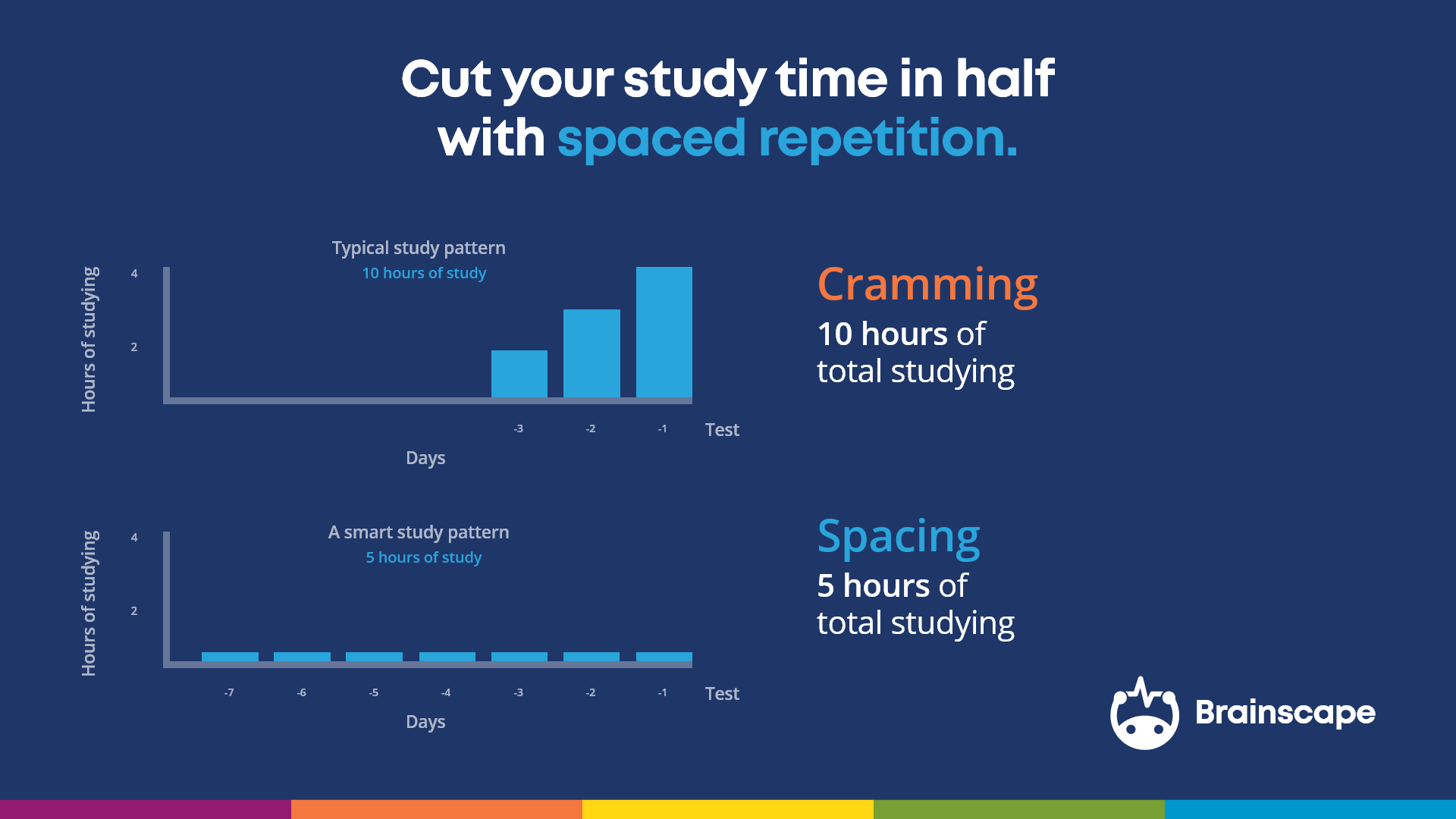
Typically, students dedicate more and more time to studying as their exam approaches, cramming an entire course or semester’s worth of material in only a few days or weeks. Sound familiar?
The problem with this approach is that by waiting so long since their initial lectures, these students have forgetten pretty much everything. And now they have to spend extra time re-learning the same concepts! Overall, these students might spend 10 hours studying, which is what we see in the "Cramming" graph.
Now let’s look at the "Spacing" graph beneath it, which shows an even distribution of time over the days leading up to an exam. This student covered the same ground in only 5 hours, spending a little time every day studying, and using a specific pattern of learning that helps the knowledge to stick.
Because of this latter approach, this student was prepared in HALF the time.
This sums up the two key ingredients in an effective study plan:
- Study in small increments across a longer period of time
- Use a specific pattern of study that makes the knowledge stick
This may sound like a no-brainer. After all, if you wanted to bench press 250 pounds, you wouldn't wait until the day before your goal to start training, spending 10 hours in the gym in an effort to “catch up”.
But this is exactly what students are tempted to do. And it has a lot to do with a lack of motivation and a tendency to procrastinate rather than study.
This is not a good plan.
But don’t worry: We're going to teach you the five principles behind an excellent study plan. Just be warned that if you have left your studying to the last minute, this will not teach you how to cram the night before a big test (<– though you can check out that article for help with that). Rather, this guide is intended as a blueprint for you to use and apply to your learning journey from its outset.
Here are those top study principles ...
Principle # 1: Learn how to read so that you learn what you read
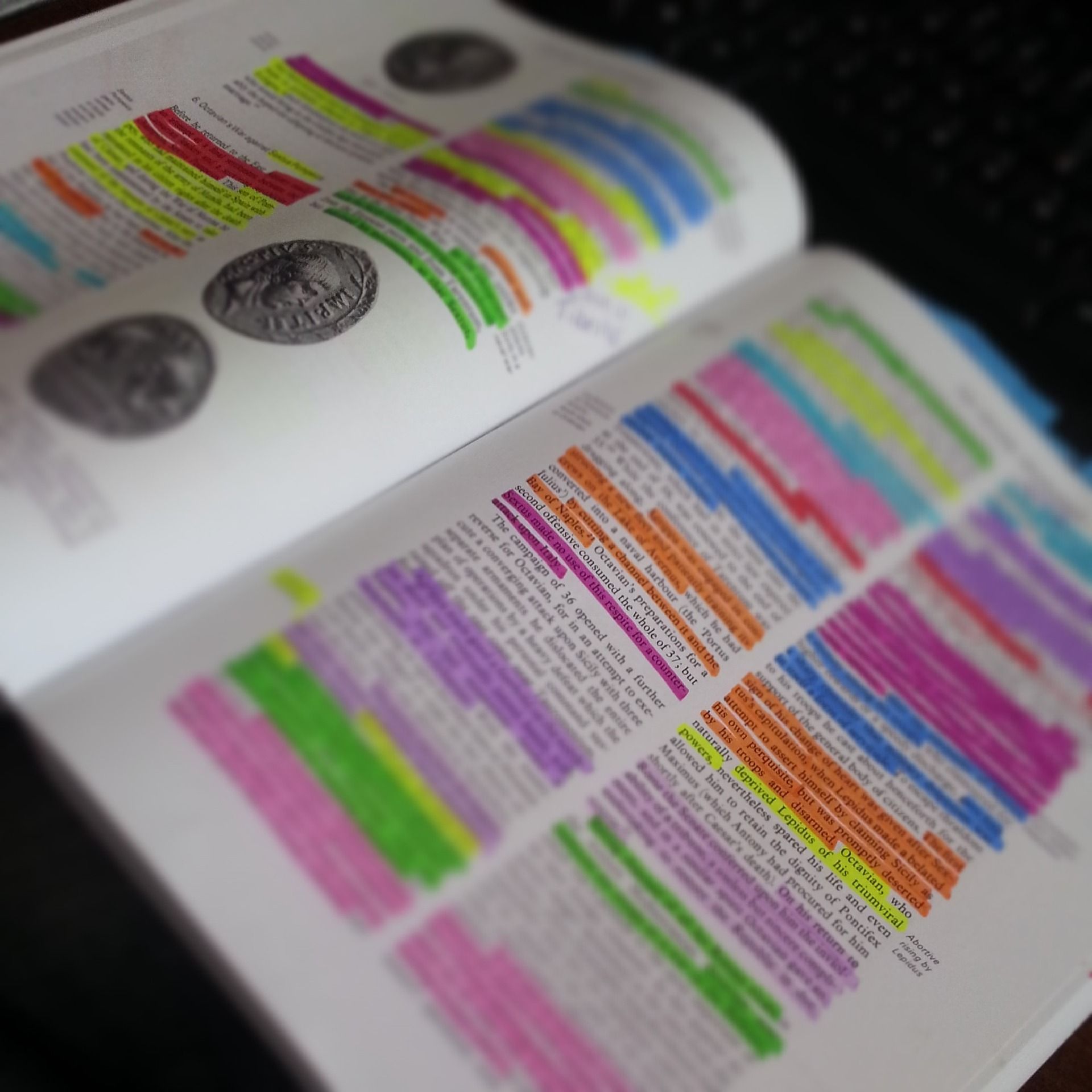
If you are in a traditional lecture class or lab, it is likely that your instructor assigns you a certain textbook chapter to read before each class. (Yeah, I know. Like ANYONE does that.) In fact, it's implicitly understood that nobody actually reads before the class. But you could be the one nerd who realizes just what an advantage this undemanding preparation gives you.
Reading the chapter or section primes your brain for learning, alerting you to what information is to come, and contributing enormously towards your ability to understand the next lecture. And since you're going to have to read the textbook at some point anyway, reading before class requires no net addition of work.
So, why wouldn’t you do it?
What we’re proposing is that you approach your reading assignments a little differently. We want you to learn to read in a way that:
- Deepens the memories you make, and
- Saves you hours of study time later on.
In other words: learn to read so that you learn what you read.
Here’s exactly how you can do that...
Step 1: Review what you learned the day before
Reviewing the previous lesson’s outline or notes provides critical reinforcement of the material your class covered the previous day. Having this kind of refresher/reinforcement event so close to the initial exposure (within 24 to 48 hours) strengthens the new memory traces your brain makes before they evaporate in the normal nightly process of forgetting. It also sets you up to smoothly onboard new information that is very likely logically connected to the previous lecture.
Step 2: Perform a quick scan of the new material

Being primed to learn makes your brain receptive to new information. So, like a military operation, you should scout ahead and see what’s coming in the coursework. This is where a quick scan read comes into effect.
Before each lecture (or the night before) scan over the section or chapter you will be covering in the next class. This gives you:
- A high-level view of what’s to come,
- Which aspects of the content are important or emphasized (and, therefore, need special attention), and
- Which questions you should be asking your teacher in class to address any points of confusion.
Some textbooks even have a series of "What will you learn?" bullets before the chapter, or a summary section at the end of the chapter, which you can read through. Why is this important?
It takes completely new information that might require some time to process and makes it familiar, even if it is just a rough outline. It also makes you curious to fill in the gaps, which brings us to the next step ...
Read: How to read faster and better
Step 3: Ask questions to fill in the gaps
Once you’ve finished scanning the chapter, put on your journalist’s hat, and think about some questions you should ask to bridge any gaps in your understanding.
For example: during World War II, there was a cascading series of conflicts and belligerent actions that eventually led to an all-out declaration of war against Germany. In approaching the subject you might ask:
- I wonder what Germany did to provoke the Allies into declaring war?
- Why did Japan side with Germany?
- What did Pearl Harbor have to do with anything?
- And what the heck ever happened to Josh Hartnett??
Jot these questions down and make sure they get answered in the next lecture. This type of inquiry puts your brain into a different mode—a questioning, problem-solving mode—which is powerful for learning and remembering information.
Step 4: Take notes
Now, return to the beginning and read through the chapter more carefully, writing down the most salient points as you go along. If you don’t care about keeping your textbook in good condition you can make a total mess of its margins, scribbling notes, highlighting and underlining sentences, and summarizing important points.
If you do care about keeping your textbooks pretty (perhaps because you want to resell them or hand them down to your sibling) you can always photocopy the relevant pages and scribble on those. Failing that, just use an exam pad or scrap of paper.
The value of taking notes is obvious: it fleshes out your understanding of the information, perhaps by adding examples, illustrations, or alternative descriptions. But there is another sneaky benefit you may not have been aware of.
Taking notes engages your powers of metacognition. (No, metacognition is not a member of the X-Men team.)
Metacognition is your awareness and understanding of your own thought processes. In other words: "thinking about your thinking."
The reason metacognition is so useful for absorbing new information is that it kicks your brain into a higher gear, forming deeper memory traces. Examples of metacognition are: Which parts of this reading are most important? How will I best remember them? Do I fully understand this concept?
The notes you make in your textbook margins will also make the material easier to review later, providing a more fleshed out and personalized study aid. Just don’t go highlighting everything on the page!
Read: How to take good notes (and how NOT to!)
Step 5: Distill the information down into punchy one-liners
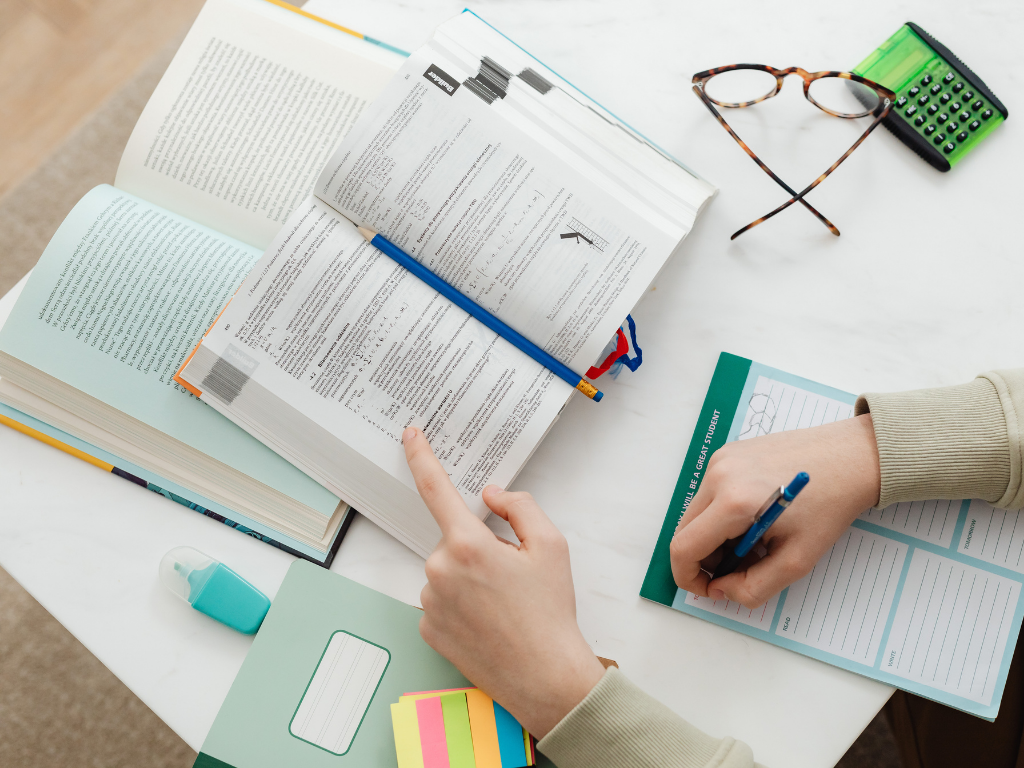
You’ve made it through the reading, you’ve taken notes and asked questions. Now, take a minute to really think about the take-home messages of the chapter or section you just read and write them down.
This potent summary not only strengthens the memory traces you’ve created in your brain, but it also isolates that section’s most poignant information. This saves you from having to tease that information out later, therefore helping you study more efficiently in the future.
Step 6: Put yourself to the test
Rather than whipping through several pages of information, which you’re never going to remember, take a little time after each section to recall aloud what you’ve just read from memory. You could even pretend to explain it to another student.
[This is called the Feynman Technique and it really, really works]
Also, most textbooks contain at least a few questions after a chapter to compel you to stop and consider what you’ve read. Answer them.
This final act of recall and assessment will make the reading material "stick" for at least a day or two, until you're able to cement it with further retrieval practice (more on this later). Testing yourself is an extremely effective memorization technique.
Here's a summary of the effective reading strategies
Do you see why this preparatory work is important? It may sound like a lot to do before you’ve even walked into your lecture but you are effectively setting yourself up for success. With this prep behind you, you’re going to understand what’s going on in the lecture, be able to ask perceptive questions and earn the respect of your teacher.
Most importantly, when the time comes to study for exams, you’re going to have a solid memory of the coursework and a gorgeous set of succinct study notes to review, while your peers are scrabbling to re-learn the entire course, practically from scratch.
Now you know how to read your textbook and materials. Just remember that it’s key to do this BEFORE your lecture, in preparation for each lesson.
If you treat this pre-reading as non-negotiable homework, “Future You” will be even more grateful than when you wake up with your wallet, cellphone, and dignity after a night of tequila and bad life choices. Success.

Principle # 2: Note-taking done properly
Students who follow Principle # 1 put themselves in a unique position when they walk into a lecture. Unlike everyone else in the room, they have already started learning the material.
They know where the narrative is heading, what the pertinent points are, and what questions need to be answered. And so, while everyone else is developing a case of carpal tunnel writing down every single word the lecturer says or writes on the board, they can sit back, listen, and absorb.
The only information they need to write down is what’s important or what they haven’t already encountered in the textbook, which often isn't very much at all. This is a concept called "flow-based notetaking" and it totally frees students up to engage in the lecture, listen carefully to the teacher, and stop to ask questions where appropriate.
Here are those important steps to proper note-taking in class:
- Do the pre-reading (see Principle # 1 above). This will dramatically reduce the number of notes you need to take in class.
- Eat the right foods beforehand so that you don’t spend the entire lecture feeling fatigued, bloated, or crampy.
- Ask questions if you've missed something or need to fill in a gap in your knowledge. If you’re concerned about interrupting class, chat with your teacher afterward.
- Jot down keywords and phrases. Don't waste time worrying about spelling, grammar, or writing in complete sentences.
- Leave large spaces between sections so that you can fill in the details later.
- Identify weak/confusing spots to follow up on after class.
Following these steps will arm you with all the information you need in order to (1) master the material and (2) ace your exams. But you’re far from done yet.
Now the real learning begins...
Principle # 3: Consolidate notes soon after the lecture

Let’s assume you’ve (1) followed through on Principle # 1’s pre-reading homework, and (2) made notes in your textbook and during class. First of all: great job! That is literally 100% more than most of your peers have done.
Now, comes the third component to establishing deeply ingrained neural pathways to that information: consolidating your notes.
This is where you improve, rewrite, or clean up the notes you’ve taken, combining the information from the lecture, textbook, and any other sources onto one sexy "cheat sheet", which you can use for future review and, of course, to study for the exam.
On this subject, timing is everything. Ideally, you should consolidate your notes immediately after the lecture or at least within 24 hours of it, taking advantage of that vulnerable time when the new knowledge could be easily forgotten. This may sound like extra work but, just as we discussed, it is an investment of time that has double the dividends at exam time.
RIGHT so what are the best ways to consolidate your notes? You can do what we initially suggested: rewriting your notes, combining all sources of information (lecture, textbook, etc.) onto that sexy "cheat sheet".
You can also take your notes and transform them into a different format entirely. This compels you to really dig deep and understand the material in order to reframe it as, for example, a concept map or in question-and-answer flashcards.
Let’s take a brief look at both of these super helpful study tools...
Tool 1: Consolidate your notes by making a concept map
This is something you probably did in primary and high school (with only the geekiest of students persisting beyond this level) so you hardly need a refresher course in how to build concept maps.
What we will say is that concept maps can work really effectively for subjects like history or science, where there are lots of interrelated concepts, events, or definitions. When you put all these concepts into a map, you establish in your mind how they’re related to each other, thereby making each separate concept more memorable.
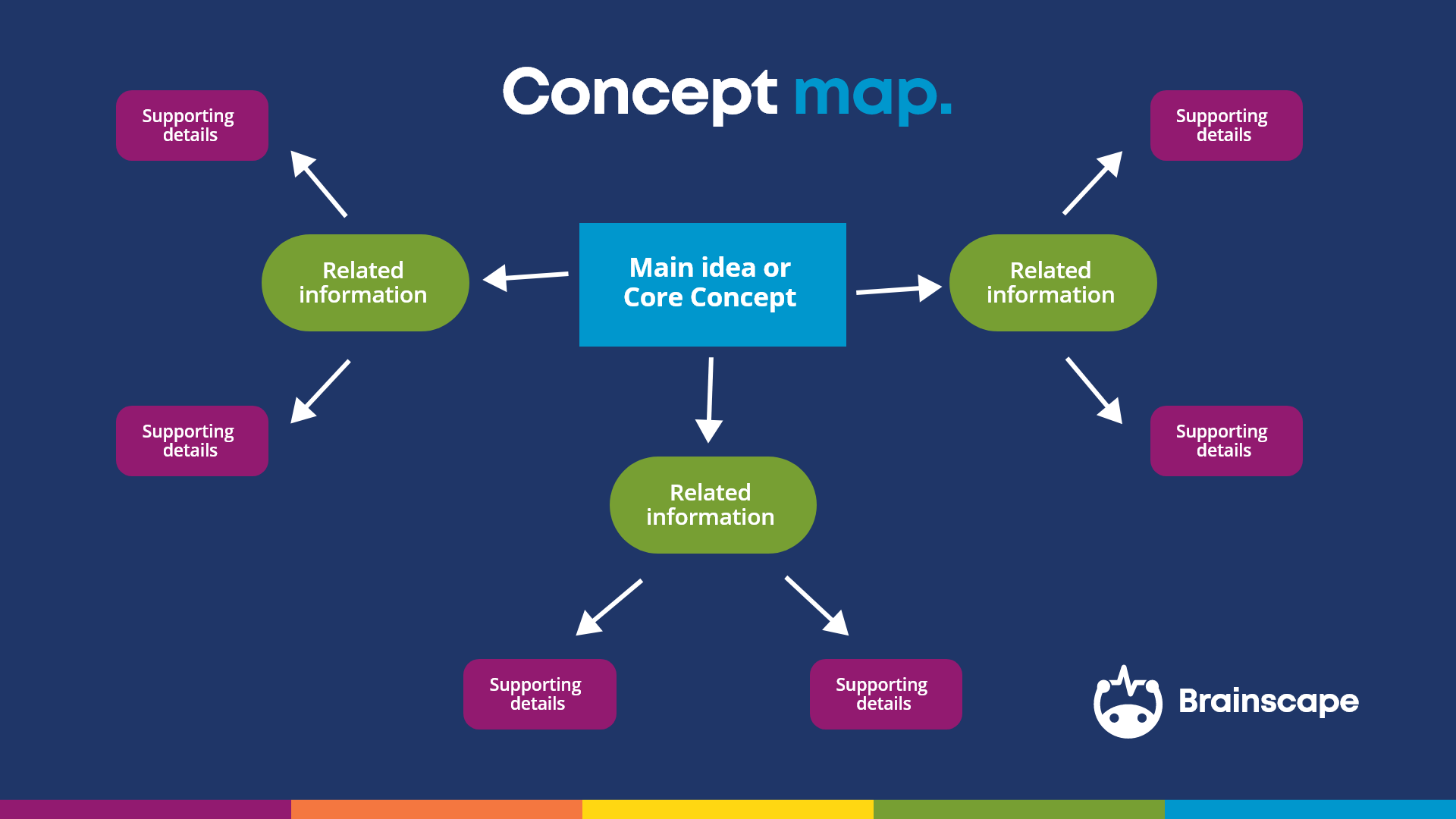
The act of making concept maps forces you to engage your skills of critical thinking, which forms more permanent, long-term memories of the information.
If you'd rather create a digital concept map for more flexible editing, sharing, and portability, here are some concept-mapping software options for you.
Tool 2: Consolidate your notes with flashcards
Naturally, flashcards are Brainscape’s favorite study tool!

Flashcards have been used for centuries by serious students as a way to efficiently learn information-dense subjects. In fact, of Brainscape’s millions of users, many are postgraduate students preparing for super high-stakes exams.
Why are flashcards so effective? What is it about those itty bitty squares of paper that can help a law graduate sail through the bar, or a premed student pass the MCAT?
The answer is that flashcards (done correctly):
- Break concepts into the most important, fundamental, and manageable bite-sized facts.
- Leverage the way your brain is hardwired to learn. Cognitive scientists call this active recall (thinking of the answer from scratch rather than passively reading through your notes or textbook)
- Facilitate spaced repetition learning (repeating your exposure to the information is how to memorize it better)
- Are the perfect vehicle for interleaving practice (switching randomly between different concepts and subjects, which strengthens your brain's neural connections to the information you're learning)
Remember right at the beginning of this article we explained that you are cognitively wired in a certain way? And that if you work with your brain—rather than struggling in spite of it or even against it—you can massively increase your rate of knowledge retention?
Flashcards do exactly this: they work with your cognitive wiring to help you learn.
This is why Brainscape’s study platform pivots on flashcards—and decades of cognitive science research—as such a useful mode of studying and information delivery.
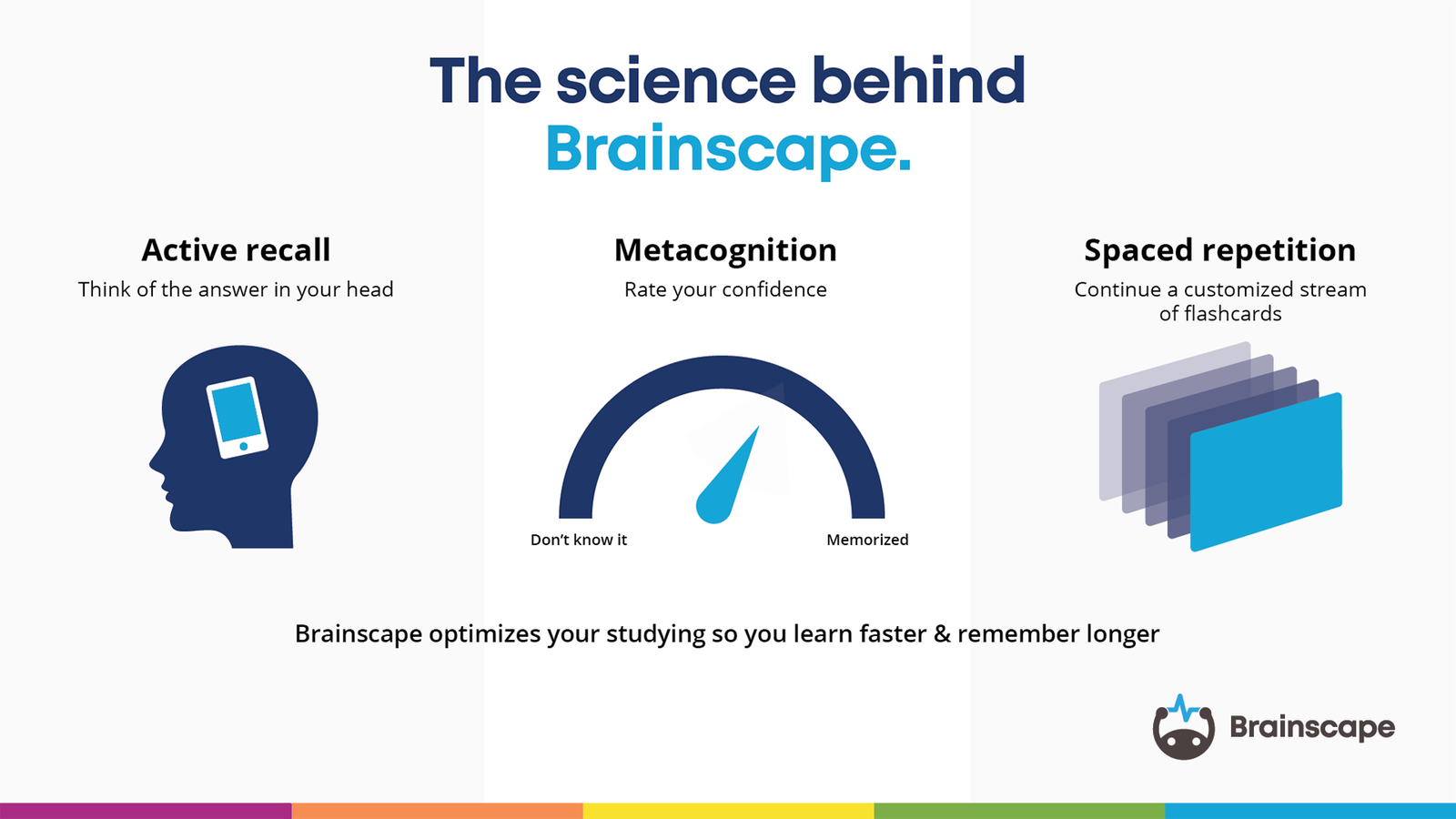
Our engaging digital flashcards break concepts down into their fundamental, bite-sized learning objectives and engage your powers of active recall, while our spaced repetition algorithm calculates the exact timing to repeat the concepts you struggle with in order to optimize your learning.
Of course, you can always make your own paper flashcards too. But whether you use Brainscape, some other online flashcard app, or good old-fashioned pen and paper, doing this forces you to reframe your study notes into question-and-answer flashcard pairs.
And as you reframe your content into this different format, you engage the higher brain functions of analysis and synthesis to further strengthen your memories.
Woohoo!

To nerd out on how Brainscape has helped millions of users smash their exams into the stratosphere, check out the cognitive science behind our flashcard software, or our comprehensive guide to using and making flashcards.
Principle # 4: Make study a daily practice
It can be hard to make a daily investment of time in your studies when you have so many other commitments on your plate: assignments to finish, papers to write, clingy boyfriends to avoid … We get it. Life is chaotic. But at few other times is it as stressful and as chaotic as it is in the run-up to exams.
Investing in learning every day (through review, preparation, and consolidation) eliminates the vast majority of this stress and chaos. And this empowers you to perform when it matters most. We’re not suggesting you neglect your assignments in favor of daily study but rather to give the latter some priority in your busy schedule. As little as 20 - 30 minutes, in fact.
In any case, exams typically count for HALF or more your overall course assessment, so why not give it the lion’s share of your attention?
The reason why creating a daily habit out of studying is so important is simple: the more we are exposed to information, the more we are likely to remember it. It’s the same reason so many people still remember their home phone number from when they were growing up ... because they used it so often.
This is why spaced repetition systems like Brainscape are such effective study tools. What places Brainscape at an advantage to other modes of flashcard study is our spaced repetition algorithm, which, based on how well you know the answer to a flashcard, calculates the optimal interval in which to show you that card again.
This is illustrated in the following animation:
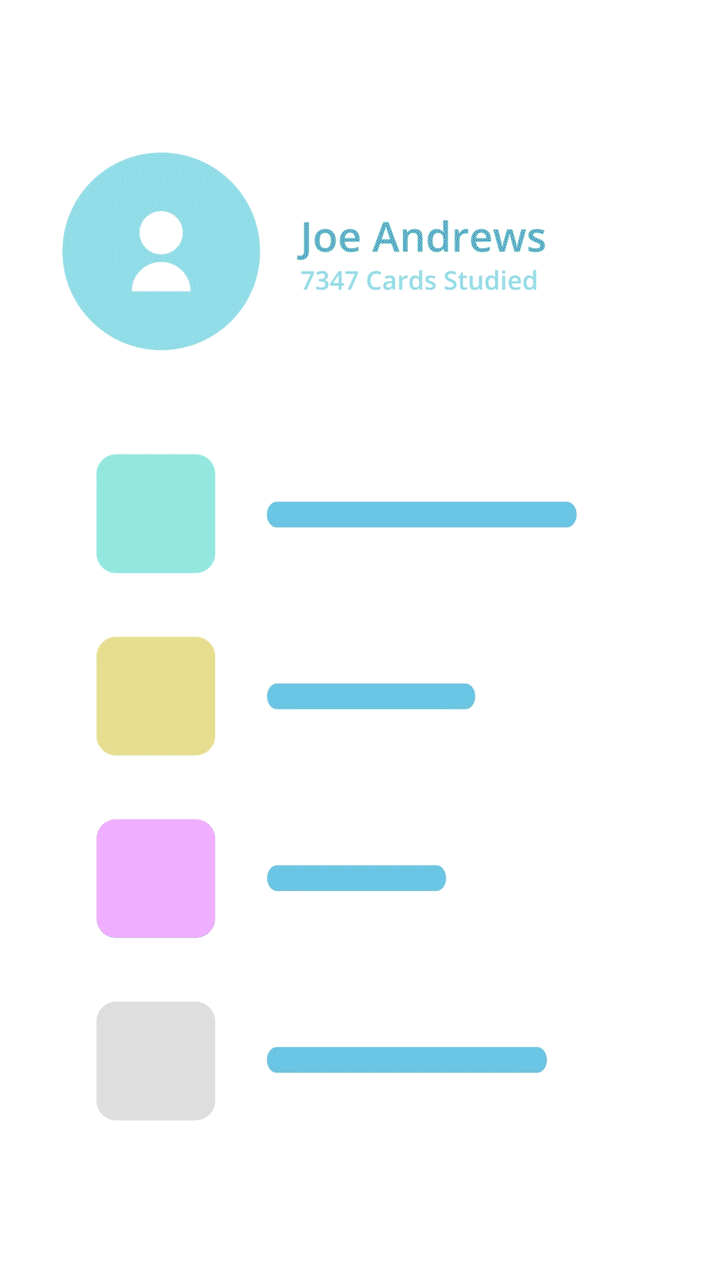
For example: if you rate your confidence a 1 out of 5 (I didn’t know this answer at all), the algorithm will likely show you that card again pretty soon. If, however, you rated your confidence 5 out of 5 (I know this answer), it will only show you that card again much later on.
This spaced repetition ensures that you onboard new knowledge quicker and more efficiently. It also compels you to address your weaknesses (1) without neglecting to occasionally reinforce the areas you’re more confident in and (2) without wasting too much time on this reinforcement.
The longer you do this daily practice, the greater the power of spaced repetition compounds. And if you practice it from the outset, you’ll approach exam time already a master of your subject!
Pro Tip: Take the guesswork and decision-making out of studying by setting study streak reminders in Brainscape: gentle “nags” to keep your daily study streak alive!
To activate, simply go into the menu in the mobile app (left), select Notifications, and then you can then toggle on Streak Reminders (top right). Those will show up as push notifications on your phone’s home screen (bottom right) reminding you to stop what you’re doing and put in a quick study round with Brainscape. You can also customize the time of day you’d prefer to receive your reminders!
Principle #5: Teach to learn
The best way to learn is to teach
If this well-known Latin principle is familiar to you it’s because it’s so popular and so true. And this is because teaching a subject unleashes the power of free recall.
Free recall is when you look into the black void that is your consciousness and summon from it information, without any kind of specific prompting. For example: reciting everything you know about a particular concept from beginning to end.
This is much more effective for learning than "prompted" or "cued" recall, which, as their names suggest, provide you with a memory jog (in the form of a question) in order for you to retrieve the information you have stored in your memory.
How can you use free recall to prepare for an exam?
As D-day approaches, take time to teach someone everything you know about your subject, progressively working through its various concepts, chapters, and topics. This could be a real person (if you can find a willing victim) or it could be an imaginary one. It could even be your pet goldfish or indoor plant. Pretend you’re the lecturer and they’re the student.
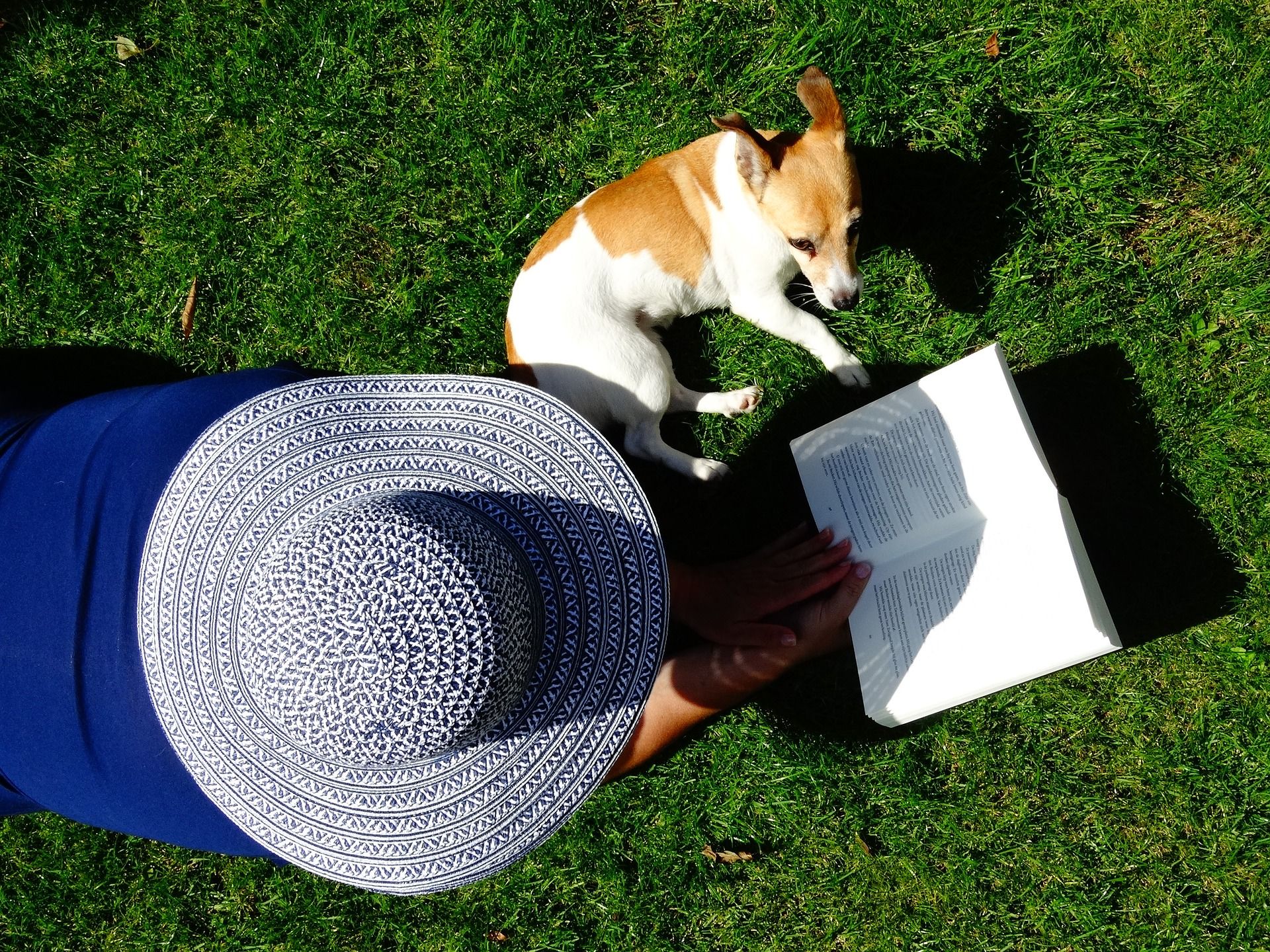
Even better, try to distill the content down to its simplest form (a strategy known as the Feynman Technique) so it’s immediately understandable to your “students”. This will also help you identify where your understanding of a topic might be lacking.
The “teaching to learn” technique works because it shifts your brain into a different mode: one of dispensing knowledge rather than trying to onboard it. This establishes yet another neural pathway to the information you’re teaching.
Reciting a massive brain dump of everything you know is the best way to solidify new knowledge, not only for an upcoming exam but permanently, for life. And the more knowledge you bank permanently, the easier it is to build on it during future classes and for real-world use.
How to study: learn or cram? It's your choice
Congratulations, you made it through Brainscape’s epic guide on how to study effectively for your exams! Here’s a plate of cookies:

So there you have it. The five principles of effective study:
- Principle # 1: Learn how to read so that you learn what you read
- Principle # 2: Note-taking done properly
- Principle # 3: Consolidate notes soon after the lecture
- Principle # 4: Make study a daily practice
- Principle # 5: Teach to learn
More than simply tips to study for a test, these principles will help you build study habits that will help you learn better. And, to supercharge your study efficiency, use Brainscape for optimal flashcard-based learning.
A final note. As we said at the beginning, there are two ways to go about studying.
Practice these tenets always, and you will fearlessly triumph overall exams and tests that come your way. Break them and you can look forward to late nights of cramming, sleep deprivation, and extreme caffeination. (And possibly poor test scores, career disappointments, and perished dreams. Not that we want to freak you out or anything ...)
There are no shortcuts.
Stay the course, and you will become one of those elite (but annoying) students like Haru, who studies only half as much as everyone else, gets plenty of sleep during study break, and ends up scoring straight A’s.
The choice (as always) is yours ...
